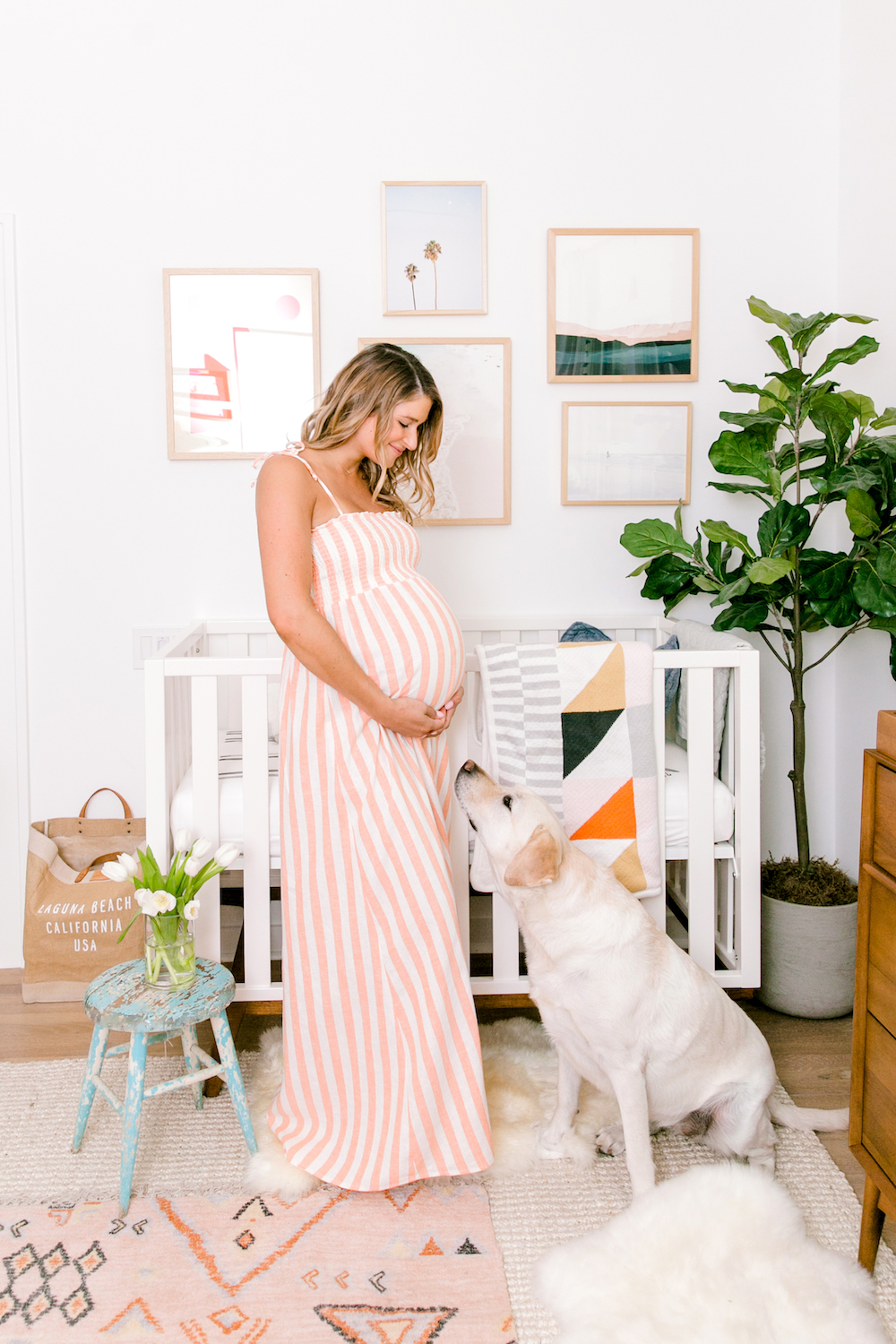As someone who has suffered from anxiety for years, I know firsthand how difficult it can be to do accomplish the simplest of tasks when I’m having a “bad day.” To outsiders, anxiety may seem silly — “just stop worrying so much!”… “relax and take a deep breath”… “you have nothing to be afraid of right now!” These are phrases I’ve frequently heard from friends and family whose intentions were in the right place, but hearing and seeing their reactions to my anxiety in the moment usually made me spiral even more.
When I’m experiencing anxiety, it’s often paralyzing; I’m unable to express how I’m feeling and why I can’t think rationally.
My head starts spinning through worst case scenarios, my chest gets heavy, my heart starts beating as fast as if I just ran up a big hill, and I break into a slow, cold sweat. My stomach turns into knots that leave me feeling nauseous, and I get a pounding headache. The physical symptoms I experience are very real, and usually even worse than the emotional ones.
When I found out I was pregnant in early 2019, my anxiety took a turn for the worse. Thoughts that I knew I didn’t believe in my heart started taking over my head, and I knew I had to do something. I wasn’t going to let my anxiety steal this special time I had waited my entire life for. I had to learn how to live with it and take my life back — for myself, my family and friends, and most of all, for the beautiful baby boy I was growing.

I started seeing a therapist weekly for two hours, and to be honest I was really frustrated when I didn’t immediately notice an improvement. It took about three months of commitment to therapy and some hard work on myself before I felt like my thoughts were finally getting quieter. Day by day, my “bad days” became less frequent, and I started to feel a little more like my true self. The tools I’ve learned in therapy have helped me recognize my triggers — before, they would slowly and invisibly pile up one after another until I finally “broke.” But now, I know what I need to do in order to take care of myself so that I can keep my anxiety in check. Balancing work with quality family time at home, moving my body daily, getting outside for fresh air and sunshine, calling girlfriends to check in, seeing my family regularly, eating food that truly nourishes my mind and body, not drinking too much caffeine or alcohol — these are all things I know I need to prioritize in order to keep my cup full, my self-confidence high, and my anxiety under control.

Of course, like any mental health disorder, anxiety can look different for everyone. What I experienced and what works for me to prevent it may not work for everyone. There’s a lot of shame and stigma around disorders like depression and anxiety, and I hope that by sharing even a bit of my story, it encourages anyone who may be feeling similar symptoms to take that first step in getting help. It can be tough to see the light when you’re constantly worried what feels like every second of every day, but it is possible to get to the other side and live with your anxiety in a way that feels manageable.

Although I have a lot of personal experience with it, I’m far from a professional expert on anxiety disorders. When researching tools and tips on how to cope, I came across this Ted Talk with psychotherapist Sheva Rajaee. Her talk spoke to me in ways that made me feel comforted and hopeful there was a way out– “I’m not crazy!” “This is real for a lot of people!” It was so reassuring to know I wasn’t alone in my struggles. After listening more to Sheva speak about anxiety and OCD disorders, (and following her inspiring Instagram), I asked if I could interview her about anxiety in hopes that it helped normalize the disorder and shed light on some common symptoms, coping mechanisms, and how to help yourself or someone else who may be struggling.
Read on for my expert interview with psychotherapist Sheva Rajaee, MFT Director of The Center for Anxiety and OCD (CAOCD). Sheva breaks down Generalized Anxiety Disorder (GAD) and what is really going on in the brain, how to live with and manage your anxiety so it doesn’t affect your quality of life, and common treatments that have been proven successful for GAD diagnoses.

What does Generalized Anxiety Disorder typically look like? For someone who may be unfamiliar with the disorder, what are some physical and emotional symptoms that someone suffering from GAD may experience?
Generalized Anxiety Disorder is an anxiety disorder that is characterized by excessive worries about various aspects of daily life. For example, GAD can involve excessive worries about one’s career, children, relationships, health or the state of the world just to name a few arenas. What characterizes GAD is that the amount of worry is typically disproportionate to the situation at hand. For example, it is typical to be worried or experience anxiety when giving a presentation at work, but if you spend hours per day thinking and worrying about this to the point where that worry is impacting your quality of life, then you might be crossing from typical worry to GAD- especially if you notice a pattern of this kind of excessive or disproportionate worry.
Interestingly, women are twice as likely to be affected with GAD than men. Those with GAD might feel physical symptoms of panic, increased heart rate, sweating, tightness of the chest and racing thoughts, and they might notice that they tend to “overthink” situations more than those around them. Feeling anxious all the time can lead to feelings of depression, exhaustion, and hopelessness, but the prognosis for GAD is very positive with the right kind of treatment.

From a scientific / biological standpoint, what is really happening in the brain?
Like all anxiety disorders, GAD affects the amygdala, the portion of the brain responsible for assessing threat in the environment and deciding what is dangerous and what is not. The GAD brain will be extra vigilant to perceived threats, for example to the possibility that you might have offended someone, or the possibility that you made a mistake at work and will send out a stress signal (anxiety) to try to protect you from perceived danger. In anxiety disorders like GAD and Obsessive Compulsive Disorder, the amygdala is often misfiring, either exaggerating threat, or creating threat where there is none at all. You might feel that it’s difficult to start your day or be productive when in the midst of an anxious episode because it takes an incredible amount of energy to “solve” the problem that anxiety poses. Oftentimes people spend hours or days trying to figure out their anxiety, but this is actually a counter therapeutic approach.
Anxiety can’t be figured out, it must be tolerated and allowed to exist, and often there is no clear answer that will make anxiety go away.

What are some natural ways to help prevent anxiety from creeping in and derailing your day?
The number one way to manage anxiety is to allow it to exist. You don’t need to listen to what anxiety is telling you in order to let it be there and to not spend hours ruminating, searching the internet for answers, or seeking reassurance from loved ones. When negative emotions like anxiety or discomfort are not fed through behavior, they will naturally dissipate on their own. Lifestyle changes like meditation can be helpful, as can going on walks in nature or using healthy distraction like socializing or engaging in meaningful activities. Many find they are soothed by taking a bath or by reading a good book, really any activity that is meaningful and engaging will be helpful. Routines can be helpful as well, for example starting your day out with prayer or meditation or ending your day with an evening ritual. Going to therapy to manage the difficulties of daily life will also help your anxiety, as will building strong social support systems. Ultimately, the goal is not to get rid of anxiety, but to let it pass all on its own.
The goal is not to rid yourself of anxiety, rather you want to tolerate it and actually grow more acceptance around its presence.
Taking a few deep breaths and reminding yourself that, “not everything I think is true, not every thought that comes to my mind is automatically meaningful or urgent” is a good way to start. Recognize that anxiety is oftentimes a false alarm and that you don’t have to pay attention to everything that it says. Another strategy is to recognize the story your anxiety is saying and welcome it in, saying something like “oh there’s that story again about me screwing up the presentation!” or, “it’s the one about me not being lovable, I see you anxiety, you can’t fool me!”

What are some common myths and misconceptions around GAD?
One common myth is that you can ‘just stop thinking about it’ or “just get over it.” Anxiety doesn’t work that way, you don’t let anxiety go, you let it be. Only when you allow anxiety to exist does it move through you and you will find relief. Other myths include the myth that GAD is all in your head and that you can choose not to have anxiety or excessive worry. Anxiety disorders are not a choice and they are not caused by anything that you did in your life–often they are the product of biology as well as upbringing, and they are not your fault.
Another myth is that anxiety makes you abnormal or that something is wrong with you if you have anxiety. Anxiety is a normal part of every human experience and is not problematic in and of itself, it’s the brain’s way of trying to keep you safe and alive. It is only when anxiety becomes excessive and gets in the way of your quality of life that it warrants a diagnosis.
What types of professional treatment can be successful for someone suffering from GAD?
The gold standard of treatment for GAD and other anxiety disorders is cognitive behavioral therapy (CBT) with exposure and response prevention (ERP). These approaches work to challenge faulty thinking and provide tools to manage anxiety spirals when they show up. They also work to decrease behaviors that feed into anxiety and make it worse, such as avoidance of feared places or people, or excessive answer seeking or googling. There is absolutely help for those struggling with GAD, oftentimes the hardest part is taking the first step.
*this post originally ran September 2020





